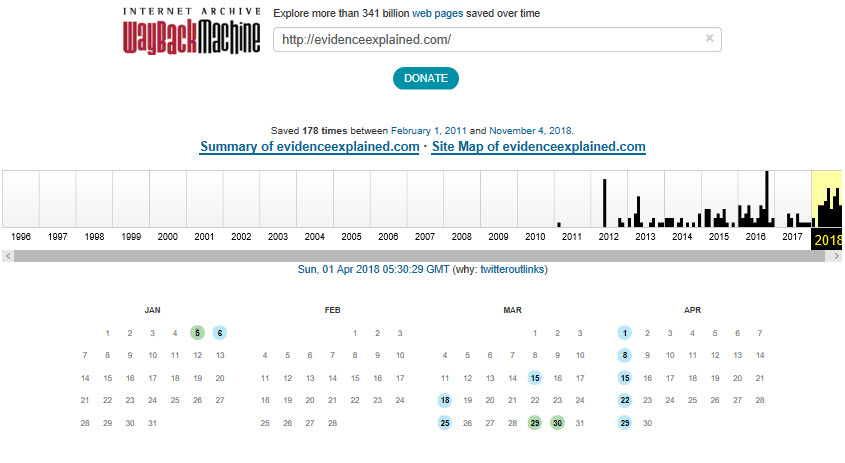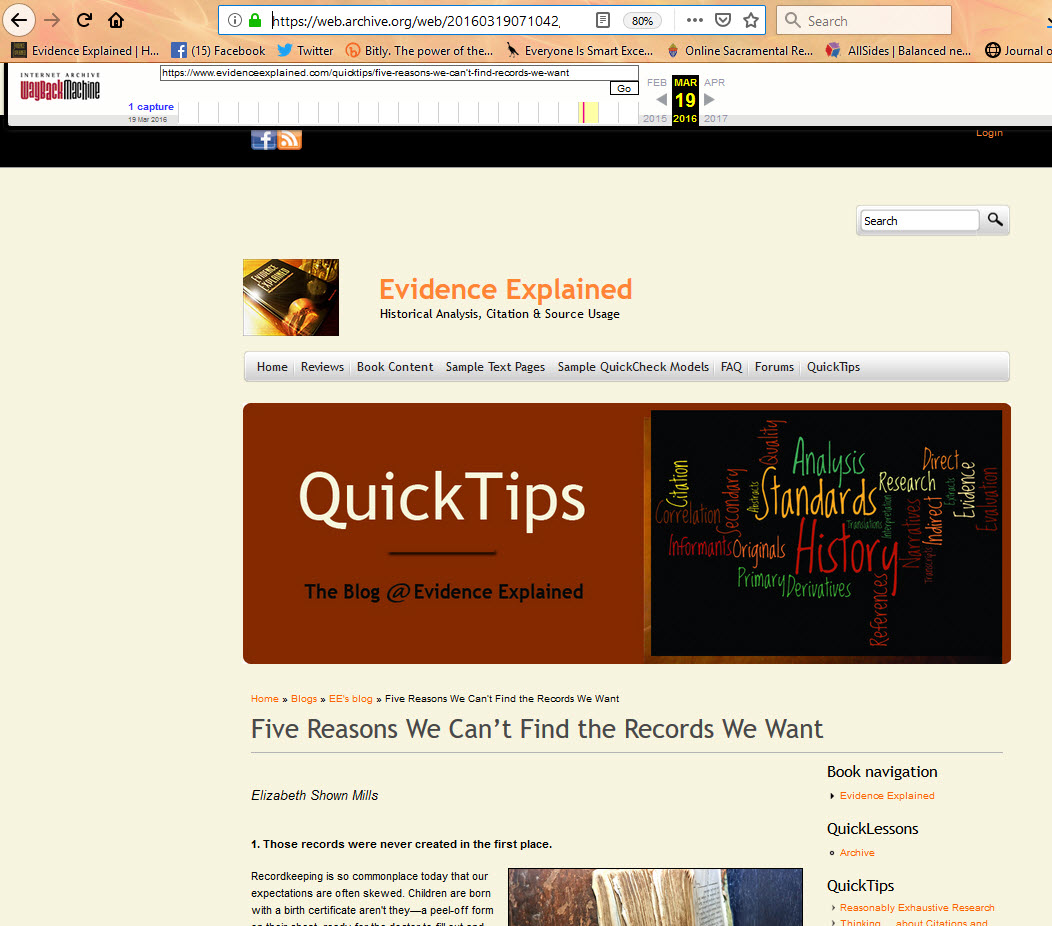Our recent Facebook discussion of the Wayback Machine triggered the inevitable question: “Just how DO we cite that source?”
Good question. It definitely can be confusing. First of all, the Wayback Machine itself is not the actual source. It (the organization) is a provider of sources. It (the website) is a republication of what’s already been published online. But Wayback (in either role) is not the creator of that material. The material already existed before the Wayback Machine found it amid its crawls of the Internet.
Wayback's calendar of 2018 captures for Evidence Explained

As with any material “archived” on line, we have two things to cite:
- The original source.
- Wayback’s website, which provides us with a captured copy of the site where the material was originally published. Well, sort of. It’s often not a full copy, but a version of it.
When we have two separate things to cite and one is embedded in the other, we create a “layered” citation. Typically:
- Layer 1 contains all details about the original source.
- Layer 2 contains all details about the website that provides a copy of the original.
Does this sound familiar? It’s the same pattern we use for citing images at Ancestry, FamilySearch, Fold3, the UK's The National Archives, or anywhere else that delivers images of records or books created by others. The two critical rules to remember is this:
- All details that describe what we’re citing in Layer 1 should stay in Layer 1. We don’t put part of those details in Layer 2.
- Vice-versa.
The confusing issues for citing the Wayback Machine lie with the site itself—particularly these two issues:
- Often, we cannot just cite a URL that will take us directly to the page we want. That specific URL may not work for someone else or for us once we’re cleared our cache.
- Once we select a date upon which Wayback captured the site, and we click on an option at the captured site, if the item we want from the site was not captured on that date, Wayback may pull that desired page from an earlier crawl and then throw another date up on our screen.
Are you confused yet?
This is one of those situations in which
- Our citation for Wayback may need to cite a path (aka waypoints) rather than a long URL.
- We may need a Layer 3 (typically used for source-of-the-source data) to cite what Wayback cites as its capture date.
Putting all this together … let’s cite a QuickTips blog posting from EE that’s now archived at the Wayback Machine. In this example, we chose the capture date "5 January 2018" because that date was late enough to cover several items in which we were interested. After Wayback presented its "mirror" of the EE site, we used EE's search function to find a specific article, "Five Reasons We Can't Find the Item We Want," posted 15 December 2015.
Wayback's 19 March 2016 capture of an EE blog post of 15 December 2015
(Accessed through Wayback's calendar entry of 5 January 2018)

You have probably noticed that Wayback's screen shows two different URLs:
- the top one is Wayback's own URL for this retrieved image.
- the lower one is EE's URL to its original page.
We do not cite either of these two URLs. The first may lead us only to Wayback's landing page. The second is not the URL we are using to access this archived page. (And if we were citing a defunct site, the second would not work at all.)
In our sample citation below, color differences mark the three layers:
- Layer 1: the original source, for which we cite the root URL
- Layer 2: the archived copy, for which we cite the root URL and the waypoint path that led to this page
- Layer 3: where we report the capture date Wayback gives us
Semicolons separate the three layers:
Elizabeth Shown Mills, “QuickTips: Five Reasons We Can’t Find the Records We Want,” Evidence Explained (https://www.EvidenceExplained.com : 15 December 2015); archived at Wayback Machine (https://web.archive.org/) > https://www.EvidenceExplained.com > 5 January 2018 > QuickTips > Five Reasons We Can’t Find the Records We Want; citing a capture dated 19 March 2016.
Done!
HOW TO CITE: Elizabeth Shown Mills, "Citing the Wayback Machine," blog post, QuickTips: The Blog @ Evidence Explained (https://www.evidenceexplained.com/quicktips/citing-wayback-machine : posted 5 July 2018).